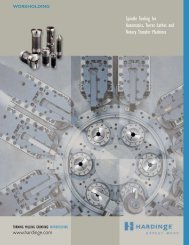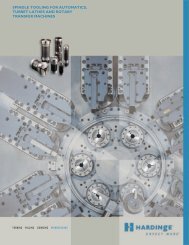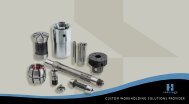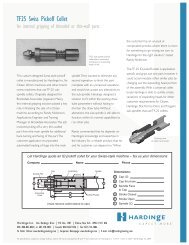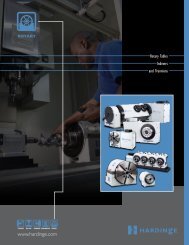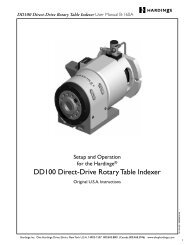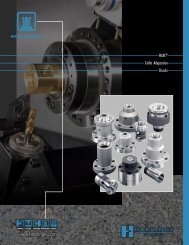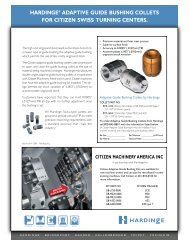You also want an ePaper? Increase the reach of your titles
YUMPU automatically turns print PDFs into web optimized ePapers that Google loves.
<strong>Sure</strong>-Grip ® <strong>Power</strong> <strong>Chuck</strong> Safety and Technical Manual B-87Z<br />
Clamping Force Check<br />
• Before starting a machining operation or when changing jobs, and in between the maintenance intervals,<br />
the clamping force should be checked by means of a clamping force gage. Regular checks will ensure the optimum<br />
performance of the chuck.<br />
Full Stroke Schedule<br />
• The chuck jaws should be moved through their complete stroke range once every twenty-four hours. This<br />
practice will return any lubricant that has been pushed away from the pressure surfaces. The clamping force will<br />
be maintained for a longer period of time as well as reducing wear to these surfaces.<br />
Special Jaws<br />
When using jaws configured different than the standard jaws, the following instructions must be followed:<br />
• Jaw Height and Weight: The special jaws must be designed in such a way that their weight and height is as low<br />
as possible. The clamping point should be as close to the face of the chuck as possible. A clamping point which<br />
is at a higher distance may cause greater surface pressure on the sliding surfaces, thus considerably reducing the<br />
clamping force as well as decreasing the life of the chuck. Many times special jaws are required by the part configuration<br />
but do not require the mass of the large top jaw. In these instances, remove as much mass as possible and<br />
still safely grip the workpiece.<br />
• Calculating the rated speed: If the special jaws are wider and/or higher than the hardened and ground single<br />
step jaws, the resulting higher centrifugal forces must be taken into consideration when calculating the required<br />
clamping pressure and RPM. For calculating the rated speed for a certain machining operation, the following<br />
formula must be applied:<br />
Fspo = initial clamping force at 0 RPM (measure in Newtons [N])<br />
Fspz = required clamping force with chuck at 0 RPM for a certain machining task<br />
(measure in Newtons [N])<br />
nmax = maximum admissible speed (RPM)<br />
m = mass of the entire jaw unit (kg)chuck and top jaws<br />
rc = center of gravity radius of the entire jaw unit (m)<br />
a = number of jaws<br />
• Welded Jaws: Welded jaws should not be used. If absolutely necessary, the weld seams must be checked as to<br />
their centrifugal and clamping force capacity.<br />
• Mounting Screws: Mounting screws must be positioned for maximum holding.<br />
Hardinge Inc. One Hardinge Drive, Elmira, New York U.S.A. 14902-1507 800.843.8801 www.hardingetooling.com<br />
11



